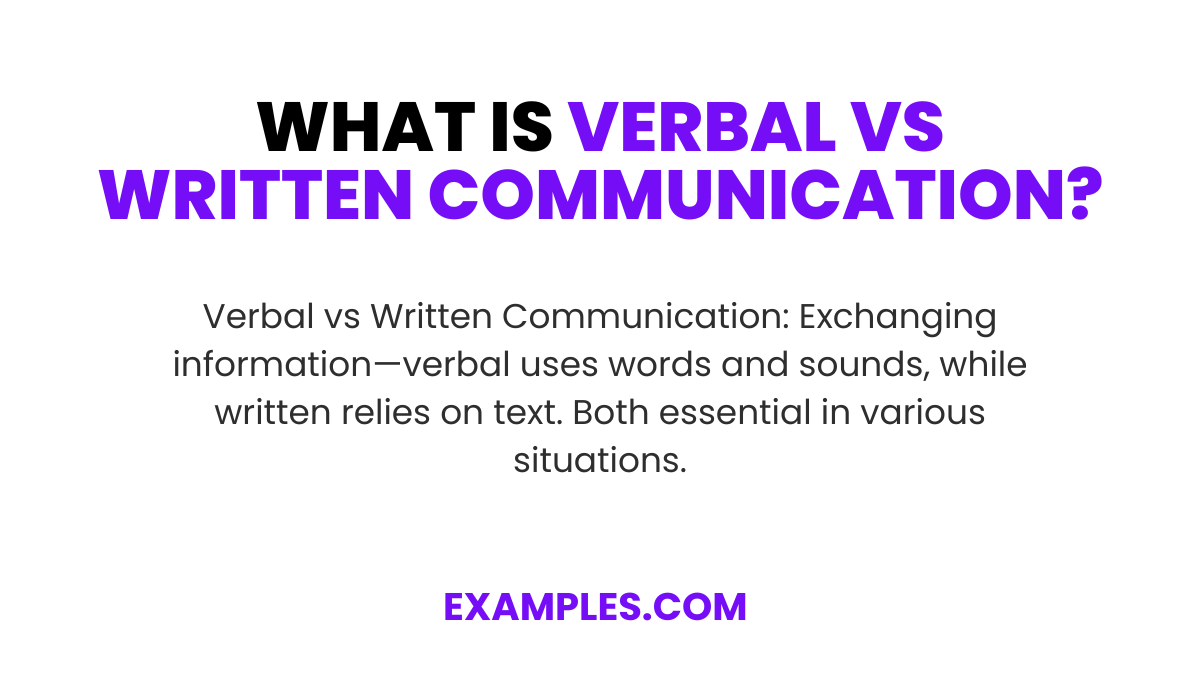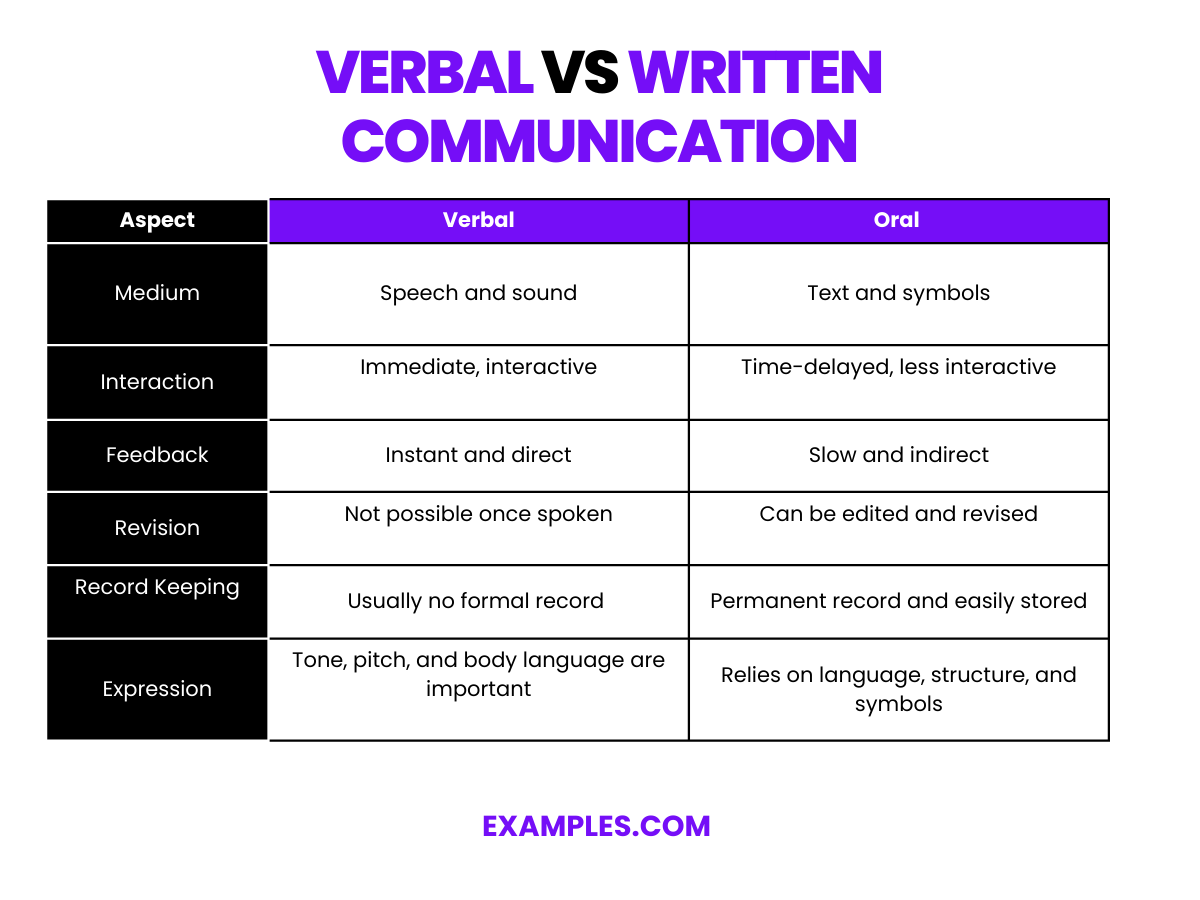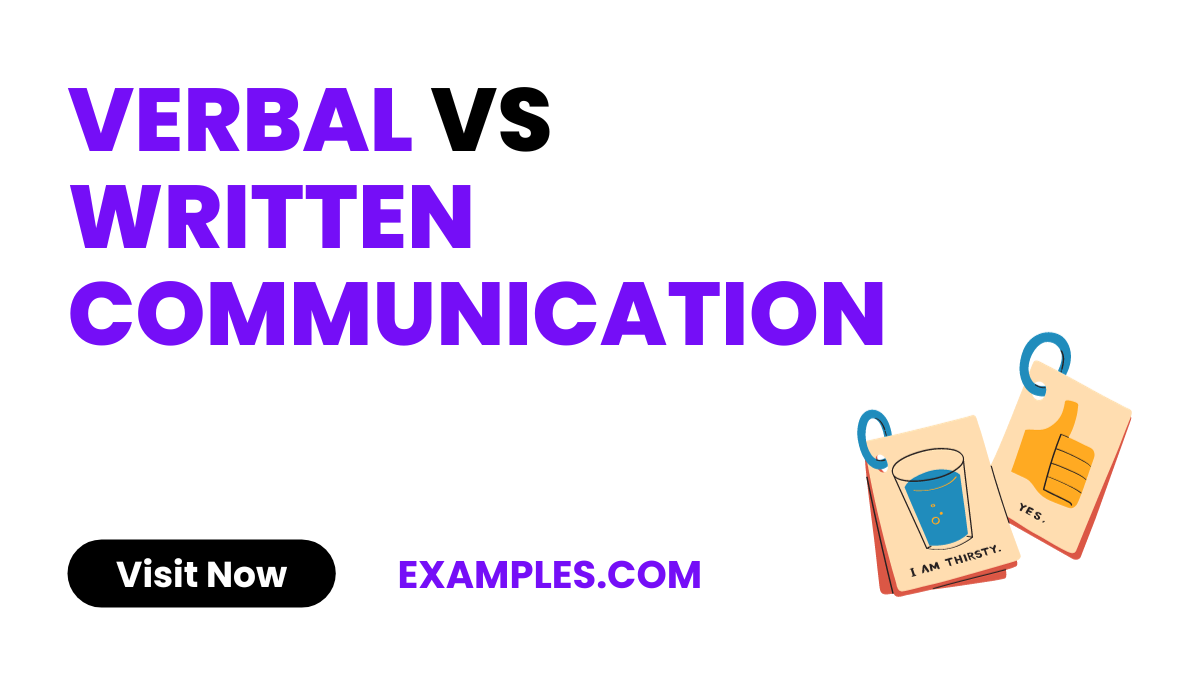Verbal vs Written Communication – 9+ Examples
Explore the intricate world of communication with our complete guide. Delve into Verbal vs Written Communication and discover how each form impacts our interactions. With vivid Communication Examples, understand the nuances that make verbal and written methods distinct yet equally powerful. This section is a treasure trove for anyone looking to refine their communication skills.
Download Verbal vs Written Communication Examples PDF
What is Verbal vs Written Communication? – Meaning

Verbal vs Written Communication refers to the two primary ways individuals exchange information. Verbal communication, encompassing both spoken and oral methods, involves words and sounds. Written communication, on the other hand, involves text and writing. Each has its place and effectiveness in different scenarios. Verbal Communication Examples include conversations, speeches, and phone calls, whereas written communication encompasses emails, letters, and reports. Understanding these differences is key to effective interaction.
What is the Difference between Verbal vs Written Communication

Understanding the difference between Verbal vs Written Communication is essential in utilizing the right techniques for effective interaction. While the Functions of Verbal Communication involve expressing emotions and immediate feedback, written communication provides a lasting record and can be edited for precision. Knowing What Percent of Communication is Verbal? helps in choosing the right method. Additionally, each has its own set of Advantages and Disadvantages of Verbal Communication, making mastery of both vital.
| Aspect | Verbal Communication | Written Communication |
|---|---|---|
| Medium | Speech and sound | Text and symbols |
| Interaction | Immediate, interactive | Time-delayed, less interactive |
| Feedback | Instant and direct | Slow and indirect |
| Revision | Not possible once spoken | Can be edited and revised |
| Record Keeping | Usually no formal record (unless recorded) | Permanent record and easily stored |
| Expression | Tone, pitch, and body language are important | Relies on language, structure, and symbols |
| Formality | Can be informal or formal | Generally more formal |
| Length and Detail | Usually brief and less detailed | Can be lengthy and more detailed |
| Understanding | Immediate clarification possible | Misunderstandings may persist |
| Accessibility | Requires the presence or technology for audio | Accessible anywhere with text capability |
10 Verbal Communication Examples
Verbal communication is an art mastered through understanding the Types of Verbal Communication and honing your Verbal Communication Skills. It’s dynamic, encompassing a range of techniques from spoken words to inflections. Effective Verbal Communication Techniques is essential in conveying thoughts and emotions clearly. Whether in personal relationships or professional settings, improving these skills is vital. Here, we explore 10 unique examples, delving into their causes and offering insights into Ways to Improve Verbal Communication Skills.
- Complimenting – Cause: Recognition of good qualities. Fix: Ensure sincerity; match body language with words.
- Instructing – Cause: Need to guide or direct. Fix: Be clear and concise; confirm understanding.
- Negotiating – Cause: Desire for a mutual agreement. Fix: Practice active listening and assertiveness.
- Debating – Cause: A difference in opinion. Fix: Respect the other’s viewpoint; focus on facts.
- Consoling – Cause: Responding to someone’s sorrow. Fix: Show empathy; use a soothing tone.
- Apologizing – Cause: Acknowledgment of a mistake. Fix: Be sincere; offer solutions to rectify.
- Reporting – Cause: Providing information or updates. Fix: Be precise and factual; avoid jargon.
- Interviewing – Cause: Gaining or providing information. Fix: Prepare questions; listen actively.
- Storytelling – Cause: Entertainment or teaching. Fix: Engage the audience; maintain a narrative flow.
- Persuading – Cause: Attempt to influence or convince. Fix: Understand the audience; provide compelling evidence.
10 Written Communication Examples
Written communication is a cornerstone in various sectors, from business to healthcare, impacting efficiency and clarity. It’s crucial in areas like Verbal Communication in the Workplace, where it enhances understanding among colleagues, or in Verbal Communication in Healthcare, where accurate patient records are vital. In Verbal Communication in Business, it drives deals and documentation, while for educators, Verbal Communication for Teachers is key in imparting knowledge effectively. Mastering written communication means addressing and amending misunderstandings promptly for smoother operations.
- Emails: Cause: Need for documented communication. Fix: Clear, concise language.
- Reports: Cause: Requirement for detailed documentation. Fix: Use structured formats.
- Patient Records: Cause: Necessity for accurate, accessible patient data. Fix: Regular updates and clear handwriting or digital entries.
- Instruction Manuals: Cause: Need for standard procedure communication. Fix: Simplify language and include visuals.
- Contracts: Cause: Legal necessity for clear terms. Fix: Ensure clarity and mutual understanding before signing.
- Lesson Plans: Cause: Requirement for structured learning. Fix: Regular review and updates.
- Newsletters: Cause: Need for regular, engaging updates. Fix: Keep content relevant and reader-friendly.
- Bulletins: Cause: Need for widespread, quick dissemination. Fix: Use clear, urgent language.
- Research Papers: Cause: Sharing of in-depth knowledge. Fix: Peer review and revise for clarity.
- Policy Documents: Cause: Legal requirement and clarity of operations. Fix: Regular reviews and updates for relevance and understanding.
Comparison between Verbal vs Written Communication
When comparing Verbal vs Written Communication, it’s vital to understand how each plays a unique role in different settings. For instance, Verbal Communication for Students encourages interactive learning and immediate feedback, essential in educational environments. Meanwhile, in more critical fields like Verbal Communication in Law Enforcement, clarity and immediacy can be lifesaving. For individuals with special needs, such as those with autism, Verbal Communication for Autism is tailored to be more receptive and engaging. Lastly, Verbal Communication for School overall promotes a nurturing environment for both learning and teaching. Here are five comparative steps reflecting these dynamics:
- Interactivity:
Verbal communication allows for real-time interaction, crucial for students and teachers in school settings.
Written communication, while less interactive, provides a permanent record for future reference. - Clarity and Precision:
Verbal communication need to be clear and followed immediately,
written communication provides detailed reports or instructions that are essential for record-keeping and legal processes. - Adaptability:
Verbal communication can be easily adapted to suit the needs of individuals with autism, using tone, speed, and simplicity to enhance understanding.
Written communication can be tailored with visuals or simple language but lacks the immediacy of tone and facial expressions. - Formality and Record-keeping:
Verbal communication is more flexible and casual, fostering a more personal connection.
Written communication often carries more weight and formality, making it suitable for official documentation in schools and law enforcement. - Efficiency and Speed:
Verbal communication is often faster and more efficient for immediate feedback and interactive learning, especially in educational settings. In contrast,
Written communication, while slower, is invaluable for detailed explanations, legal documentation, and instructions that require accuracy and permanence.
Relationship between Verbal vs Written Communication
The relationship between Verbal vs Written Communication is intertwined and complementary, each enhancing the other in various contexts. To appreciate their connection, consider the following aspects:
- Development and Improvement: Mastering How to Improve Verbal Communication Skills can significantly impact one’s written communication. The clarity and thought process developed verbally often translate into more coherent and effective writing.
- Necessity in Skillsets: Understanding Why you need Verbal Communication Skills highlights the importance of verbal prowess in conveying emotions and intentions, which are often reflected and supported in written forms. Effective verbal skills lead to more persuasive and impactful writing.
- Mutual Reinforcement: The Importance of Verbal Communication lies in its immediacy and personal touch, which helps in forming connections and understanding. Written communication, while less immediate, provides a detailed and permanent record that reinforces what is spoken verbally.
- Guiding Principles: Rules of Verbal Communication such as clarity, brevity, and tone are equally applicable to written communication. These rules help ensure that the intended message is conveyed accurately in both forms.
- Interchangeability and Support: In many scenarios, verbal and written communication are used interchangeably or to support each other. For example, a Verbal Agreement might be followed by a written contract, or a complex verbal explanation may be supplemented with written documentation for clarity. This symbiosis enhances overall communication efficacy.
In conclusion, understanding the nuances of Verbal vs Written Essential Communication is for effective exchange. Each form has unique examples, effects, and signs that demand specific strategies for enhancement. Recognizing the distinctions, including the subtleties between Verbal vs Oral Communication, empowers individuals to choose and fix the right mode for every context, ensuring clarity and understanding.



